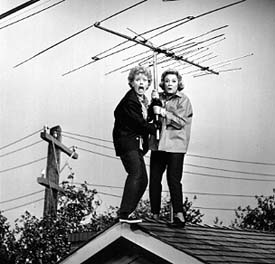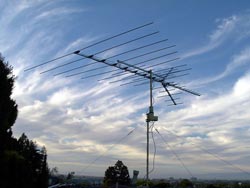Back To The Rabbit-Eared Future
April 01, 2008 || Filed under: Original
Material

Many of my friends and family members have been asking me for advice on which HDTV to buy. After reviewing their unique environment and needs, I respond with a recommendation on a particular TV set and tell them to buy a good antenna to go along with it.
Most of the time, I get a pretty odd response, like “But my cable provider gives me HDTV, what’s with the antenna?” I smile and start to explain…
Our current TV standard in the United States is NTSC, an analog signal that produces 525 lines of resolution (although only 486 are viewable area). The HDTV standard, which by the way is a group of standards, is a digital signal with resolutions like 720p, 1080i and 1080p. By its nature, HDTV requires much more bandwidth to deliver its superior picture quality.
Your local channels broadcast its signal over-the-air in NTSC today. They do so in uncompressed fashion, giving its audience the opportunity to receive the best possible picture. When the DTV cutover occurs in 2009, broadcasters will send a digital signal (DTV) to its audience via their broadcast tower in “uncompressed” format. I put the word uncompressed into quotes because often a TV station will have already converted, compressed or otherwise manipulated the original program several times before it is broadcast to you. For the sake of our conversation, however, we’ll assume the signal coming out from a TV station’s digital broadcast tower is pristine and uncompressed.
Enter cable and satellite providers. We all want lots of channels and choices, so cable and satellite operators oblige. They take their physical cable or satellite transponder bandwidth and fit in as many channels as they possible can. And guess what? They can’t fit in all those channels we want without compressing them!
Even with NTSC signals, cable and satellite providers are compressing the signals to some degree. This will only be exacerbated when we move to DTV/HDTV in March 2009 and they have so much more to cram into the same fixed bandwidth. The results are both perceptible and measurable. Go to your best TV in the house and wait for some white text to displayed (like during newscasts) and look around the edges of the letters. See the jagged “interference”? How about a fade to or from black…see the blocks or odd discoloration? You can thank compression for that.

So, whether you are buying a 20” or 90” TV, if you want the best possible picture you’ll be picking up an old fashioned antenna with your high tech TV.
Addendum:
Under most practical scenarios, you’ll still likely to use cable or satellite as your everyday source of content. It’s far easier to channel surf a mix of channels that way. But, when you’re ready to have that TV really blow you away, break out the rabbit ears and enjoy.
|
